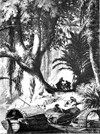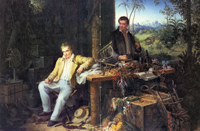Meeting 5 • 21 January 2014
|
Version: |
|
pictures of the week
|
|
|
|
mini-text of the week (start): "The farm we lodged at was a fine sugar-cane plantation.… The owner's house is situated on a hillock surrounded by huts for the negroes.…"Humboldt, "Personal Narrative", from Jaguars and Electric Eels, ed. & trans. Wilson, p. 22 (read more) |
portraits of AvH; work sample: "Leaving Home"; apps related to navigation; 2013 projects
|
(05')√ Thought-bite of the week: a) plants, rocks, altitudes, and facts, opinions, and values – We're getting to the meaning of "sustainable environmentalism", in the sense of using knowledge and reasoning to examine decisions about how to manage (or not manage) our surroundings. How much do we really know about the data – what it is, how much there is, how it was gathered? Data points vs data ranges: |----•----| What they knew then, what we know now (and how much of what we know now is based on incorrect knowledge). How errors of measurement magnify (example: astronomy) |
|
(5')√ Mini-text of the week (maybe save for next meeting): 1) What sorts of people did Humboldt encounter in Venezuela? (=an informal quiz on the reading). 2) What do we know about prices in the past (food, housing, wages, etc.), and how much can we compare them to the present (= yet another dimensions of "interpreting the past"). 3) The tricky topic of slavery. |
|
(20')+ Review of last week's quantitative activity and expansion to applications related to travel, exploration, and sustainability (basic quantities worksheet, stage 2 • later: basic quantities worksheet stage 3 • basic quantities worksheet stage 4). Comment: Last week people filled in a fair amount of quantities, but indicated very little about how they actually determined those quantities (whether by showing calculations or by giving the sources of their information, for example "personal experience on a flight" or "remembered from middle school math"). The LONGITUDE problem - key to understanding accuracy of mapping and, therefore, recording geophysical data, including weather/climate and biology. The LATITUDE topic: not a problem, really, but a key element in Humboldt's development of modern concept of geographical distribution of life-forms. Key factoid: how long is a degree/minute/second of longitude at what latitude? Why would travelers want to know that? A look at some mobile apps (here: iPhone/iPad) about navigation and measurement. Next meeting you'll apply your quantities to determine some real-world (sometimes life-or-death) quantities needed by people who had to get across and around the globe in earlier times, and also some quantities that we encounter in discussions of sustainability. |
|
(10')N more about Humboldt-named schools and their role in this course; featured schools: PDX (now closed - summer of 2012), Arizona, CA (Humboldt BAY HS), Illinois (AvH Chicago), NYC, Saskatchewan, Mexico City, Puebla, Berlin-Tegel, Hamburg, Rüsselsheim, Kazakhstan; reinterpreting the past better for ourselves by (re)interpreting it for others. Upcoming: choosing your Humboldt-named school as source of info about education and possible beneficiary of your project(s) |
|
(10')N presentation about educational standards and their parts in the course: 1) evaluating own education; 2) helping others to learn; preview of upcoming writing assignment and skills questionnaire. Documents: Oregon preK-12 standards for Visual & Performing Arts (0693), especially pp. 8-10, 12, 14, & (especially) 26. Discussion topic: which standards were addressed by writing about the Humboldt portrait? |
|
(5')N The Weitsch portait of AvH: relation to long tradition of portrait painting (and photography, including the pics you take of yourselves to express your identity/ies); the emergence of the scholar/ scientists as claimed co-equal of the ruler, churchman, soldier. |
|
(10')+ about writing skills and critical thinking: ways to structure "Leaving Home"; work sample (see handout from meeting #3); importance of a concept of change (in our individual lives, in development of human thought - was it always around? -, in study of origins of sustainable environmentalism) |
|
(5')+ Previews & announcements:1) Note how I have annotated the outlines for previous meetings with comments (key to symbols) about what happened during them; 2) Possible activity: rtraits of ourselves as environmentalist-explorers. 3) Upcoming: choosing areas of specialization for individual reading, lesson-plan project, team project. 4) Keeping up with the reading – see "schedule" page; maps now available; pagination of printed vs. e-books. 5) a leftover from the Hawaiian trip - while you're thinking about such things as chocolate, macadamis nuts, and coffee, look at Jaguars and Electric Eels (p. 21) and these links (link 1 • link 2) to see how modern AvH was in his beverages, and read Jaguars p. 44 about his fashionable food interests. 6) Soon we'll load and crew a mockup Humboldt Canoe - still thinking about SINQing a real canoe |

